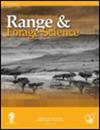半干旱环境下覆盖仙人掌与谷子间作的牧草产量、竞争与经济效益
IF 1.9
4区 环境科学与生态学
Q3 ECOLOGY
引用次数: 9
摘要
本研究旨在量化灌溉条件下仙人掌间作谷子与单作相比的饲料产量、经济效益、生物效率和竞争能力。该实验在巴西半干旱地区进行了两年多。试验设计为随机分组,有4个重复和6个处理:不加地膜的单一作物仙人掌;有覆盖物的单作仙人掌;无地膜的单作谷子;有地膜的单作谷子和间作谷子的仙人掌,不论有无地膜。覆盖和间作对仙人掌鲜物质(270 t ha−1)和干物质(23 t ha−1)单产没有影响。覆盖提高了单作谷子的鲜物质单产(69.7 t ha - 1)和干物质单产(23.4 t ha - 1)。间作系统的干物质总量大于间作系统,覆盖(32.8 t ha - 1)和未覆盖(31.4 t ha - 1),平均经济效益指数为8404 BRL ha - 1。仙人掌-谷子的结构,不管使用地膜,但在干旱环境或一年中的干旱时期进行灌溉,比单一作物更有利,因为它促进了产量的增加和食物的多样性,以满足牛群的需求。本文章由计算机程序翻译,如有差异,请以英文原文为准。
Forage yield, competition and economic benefit of intercropping cactus and millet with mulch in a semi-arid environment
This study aimed to quantify forage yield, economic performance, biological efficiency and competitive ability in cactus intercropped with millet, compared with their monocrops, both with and without mulch, under irrigation. The experiment was conducted over two years in semi-arid of Brazil. The experimental design was of randomised blocks with four replications and six treatments: monocropped cactus without mulch; monocropped cactus with mulch; monocropped millet without mulch; monocropped millet with mulch and cactus intercropped with millet, with and without mulch. The individual yields of fresh (270 t ha−1) and dry (23 t ha−1) matter in the cactus were not affected by the mulch or by intercropping. Mulching improved the individual yields of fresh (69.7 t ha−1) and dry (23.4 t ha−1) matter in the monocropped millet. Total dry matter was greater in the intercropping systems, both with (32.8 t ha−1) and without (31.4 t ha−1) mulching, being the average monetary advantage index equal to 8 404 BRL ha−1. The cactus-millet configuration, irrespective of the use of mulch, but irrigated in dry environments or during dry periods of the year, is more advantageous than the monocrops, because it promotes gains in production and food diversity for meeting the demand of the herd.
求助全文
通过发布文献求助,成功后即可免费获取论文全文。
去求助
来源期刊

African Journal of Range & Forage Science
ECOLOGY-ENVIRONMENTAL SCIENCES
CiteScore
4.00
自引率
14.30%
发文量
35
审稿时长
>12 weeks
期刊介绍:
The African Journal of Range & Forage Science is the leading rangeland and pastoral journal in Africa. The Journal is dedicated to publishing quality original material that advances rangeland ecology and pasture management. The journal aims to publish research of international importance from any region, but as an African journal, we are particularly interested in research from Africa and relevant to the continent. The Journal promotes both science and its application and authors are encouraged to explicitly identify the practical implications of their work. Peer-reviewed research papers and research notes deal primarily with all aspects of rangeland and pasture ecology and management, including the ecophysiology and biogeochemistry of rangelands and pastures, terrestrial plant–herbivore interactions (both domestic and wild), rangeland assessment and monitoring, effects of climate change on rangelands, rangeland and pasture management, rangeland rehabilitation, ecosystem services in support of production, conservation and biodiversity goals, and the identification and development of intensive and semi-intensive pasture and forage resources to meet livestock production needs. Articles highlighting transdisciplinary linkages among biophysical and social sciences that support management, policy and societal values are particularly encouraged. The Journal includes relevant book reviews and invited perspectives that contribute to the development of range and forage science. Letters to the editor that debate issues raised in the Journal are acceptable. The African Journal of Range & Forage Science is the official journal of the Grassland Society of Southern Africa.
 求助内容:
求助内容: 应助结果提醒方式:
应助结果提醒方式:


